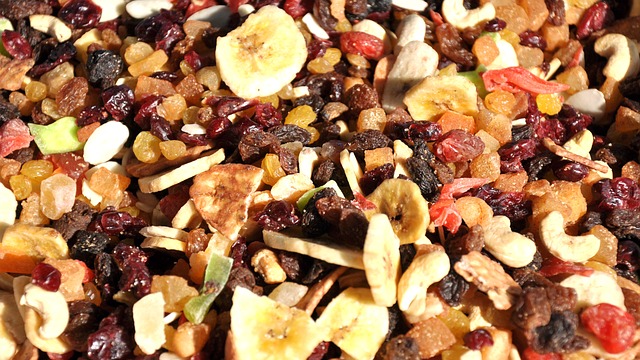Health
Health Benefits of Dried Fruit

Fruit has long been seen as nature’s own candy. It’s tasty, delicious and good for us in so many ways. One issue with fresh fruit, however, is its shelf life. This is where dried fruit comes into play. A collection of organic dried fruit on the shelf can serve a source of daily snacks for much longer than fresh, while still packing great flavour and nutrients.
Dried fruit actually comes with a raft of its own health benefits. Whoever said that making food more convenient and lasting had to take away from the nutritional value?
1. More Nutrients Packed In
In terms of weight, dried fruit boasts as much as 3.5 times the vitamins, minerals and fiber that you get in fresh fruit. The nutrients get a lot more condensed when the fruit is dried. You do sometimes lose out on some select nutrients like vitamin C, the content of which is reduced during the drying process. However, other nutrients such as fiber, and antioxidants like polyphenols are in particular abundance, all of which bring positive benefits to you.
Polyphenol antioxidants can improve your blood flow and your digestion, and in doing so can help to lower the risk you might have of getting certain diseases. The additional fiber that you get can help to fight heart disease and obesity, as well as some types of cancer.
2. Sweet and Tasty with No Added Sugar
Dried fruit is a great way to indulge one’s sweet tooth without overdoing it in the sugar department. Some care is required on the part of the consumer to make sure that what they are purchasing is indeed free from added sugar. Dried fruit retains its own natural sugars for a sweet taste, but some manufacturers do add extra sugar, which negates some of the health benefits. When you get the pure fruit with no added extras, however, the sweet taste is often amplified in dried fruit, making it a more satisfying way to enjoy healthy food.
3. Can Boost the Immune System
There are some claims that certain dried fruits such as dried goji berries can boost one’s immune system thanks to their elevated content of iron, vitamin A, as well as vitamin C. They’re also lower in calories than other fruits, as well as in carbohydrate content. Those select dried fruits that don’t lose as much vitamin C during the drying process make them an easy source of vitamin C, with huge amounts loaded into one fruit packet.
4. Can Promote Weight Loss Through Boosted Metabolism
Some dried fruits out there can work wonders in boosting your metabolism, which in turn can deliver more energy and help the process of weight loss. It’s not to say that simply eating dried fruit makes you lose weight, but it can be a great ally in your dietary arsenal.
Snacking on dried fruits like apricots, dates, and raisins can reduce your cravings for unhealthy snack foods. Taking on vitamins, minerals and antioxidants from dried fruits while satisfying your hunger is much better than taking on the salt, sugar and fat of other snack foods.
5. Great for Skin Health
Another area of your body that loves your intake of dried fruits like mangos, raisins and others is your skin. Many dried fruits contain elevated levels of omega 3 and other fatty nutrients that provide a boost to your skin health. Raisins, for instance, even have resveratrol, which acts as an aging inhibitor on your skin.
Despite some claiming that dried fruit isn’t as healthy as you might think, the consensus among medical experts seems to be that while consumers have to be mindful about added sugar and preservatives, dried fruit on balance is a healthy food and a great source of many beneficial nutrients.
Health
Addressing Common Myths About Vitamins and Supplements by Amanda Tirado

The wellness industry is filled with advice about vitamins and supplements, but not all of it is accurate. Many people rely on supplements for better health, but misunderstandings about how they work can lead to wasted money or even potential harm. Amanda Lorena Tirado, founder of Xmy, is passionate about educating people on making smarter supplement choices. Her company focuses on high-quality, effective products while also giving back to the community through charitable initiatives. Let’s break down some of the most common myths about vitamins and supplements so you can make informed decisions.
One of the biggest myths is that all supplements work the same way, regardless of how they are taken. Many don’t realize that traditional pills and capsules have to pass through the digestive system, where stomach acid and enzymes break them down. This can significantly reduce the amount of nutrients your body actually absorbs.
In contrast, oral strips and liquid supplements enter the bloodstream more quickly, making them more effective. For example, vitamin B12 is often poorly absorbed in pill form but is much more bioavailable in liquid or sublingual forms. Choosing the right delivery method is just as important as picking the right supplement.
Another misconception is that supplements can replace a healthy diet. Many people assume taking a daily multivitamin covers all their nutritional needs, but that’s not how the body works. Supplements are designed to support a good diet, not replace it. Whole foods provide more than just vitamins, they contain fiber, antioxidants, and other compounds that work together to benefit your health.
For example, an orange does not just offer vitamin C. It also provides fiber, flavonoids, and other nutrients that enhance absorption and support overall health. Research has shown that people who get their nutrients from food rather than supplements tend to have better long-term health outcomes. So while supplements can help fill gaps in your diet, they should not be your primary source of nutrients.
Many people also assume that if a supplement is labeled as “natural,” it must be better and safer. But that’s not necessarily true. The term “natural” is often used as a marketing tool rather than an indicator of quality or safety.
Some natural ingredients can be harmful, especially in high doses or when mixed with certain medications. On the flip side, some synthetic nutrients are actually more stable and easier for the body to absorb. The key is to choose well-researched, high-quality supplements from reputable brands rather than relying on misleading labels.
Another dangerous myth is that taking more vitamins means better health. Some believe that if a little is good, a lot must be even better, but that’s not always the case.
Certain vitamins, especially fat-soluble ones like A, D, E, and K, can build up in the body and become toxic if taken in excessive amounts. Too much vitamin A, for example, can lead to liver damage, while excessive vitamin D can cause kidney problems. Even water-soluble vitamins like B-complex and C can cause side effects in very high doses, such as nerve issues or stomach discomfort. Moderation is key when it comes to supplementation.
At Xmy, the focus is not just on convenience, it’s about real impact. The company is committed to producing supplements that prioritize effectiveness and bioavailability. But their mission goes beyond selling products.
Misinformation about supplements is everywhere, but being informed is the best way to make smarter health choices. The way a supplement is absorbed matters as much as what’s in it. A balanced diet is still the foundation of good health, and more vitamins don’t always mean better results.
Xmy is changing the way people think about supplements. Amanda and her team believe that good health is not just about what you take, it’s about making informed choices and supporting brands that genuinely care. Choosing the right supplements means choosing a brand that stands for something bigger. With Xmy, you are not just improving your health, you are supporting a company that is making a real difference.
-

 Tech5 years ago
Tech5 years agoEffuel Reviews (2021) – Effuel ECO OBD2 Saves Fuel, and Reduce Gas Cost? Effuel Customer Reviews
-

 Tech6 years ago
Tech6 years agoBosch Power Tools India Launches ‘Cordless Matlab Bosch’ Campaign to Demonstrate the Power of Cordless
-

 Lifestyle6 years ago
Lifestyle6 years agoCatholic Cases App brings Church’s Moral Teachings to Androids and iPhones
-

 Lifestyle5 years ago
Lifestyle5 years agoEast Side Hype x Billionaire Boys Club. Hottest New Streetwear Releases in Utah.
-

 Tech7 years ago
Tech7 years agoCloud Buyers & Investors to Profit in the Future
-

 Lifestyle5 years ago
Lifestyle5 years agoThe Midas of Cosmetic Dermatology: Dr. Simon Ourian
-

 Health7 years ago
Health7 years agoCBDistillery Review: Is it a scam?
-

 Entertainment6 years ago
Entertainment6 years agoAvengers Endgame now Available on 123Movies for Download & Streaming for Free
